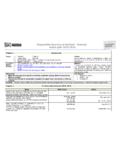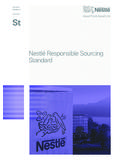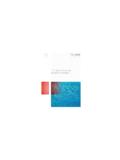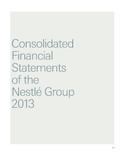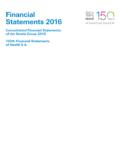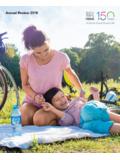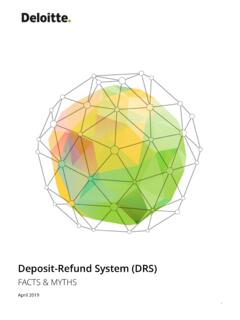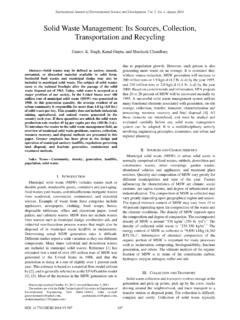Transcription of The Rules of Sustainable Packaging - Nestlé
1 The Rules of Sustainable Packaging Vevey, Switzerland, May 2020. Copyright & Confidentiality: All rights belong to Societ des Produits nestl SA. M. a Our Way Forward The purpose of this document is to provide a comprehensive set of the most up-to-date standards, THE. Rules OF Sustainable Packaging , that are driving our Sustainable Packaging transformation and helping to achieve our commitment that 100% of our Packaging will be recyclable or reusable by 2025. This document provides an overview of: o Our Packaging vision and commitments o The Golden Rules ', which guide current & future Packaging design o The Negative List', explaining the materials to be removed and by when 2 May 2020 Copyright & Confidentiality: All rights belong to Societ des Produits nestl SA. Our Vision None of our Packaging , including plastics, ends up in landfill or as litter. 3 May 2020 Copyright & Confidentiality: All rights belong to Societ des Produits nestl SA. Owning Our Commitments Changing the way we interact with Packaging , 1.
2 Requires us to rethink the way we produce and 100% 2. Support well- consume. We need to ensure that the changes we of our Packaging functioning collection , is recyclable or reusable make to our Packaging and delivery system work for sorting and recycling by 2025. schemes. Reduce our the communities that enjoy our products around the virgin plastic usage by world every day. It is about exploring multiple 1/3rd by 2025. solutions and it requires collaboration and innovation 3 Innovate with new on a global scale. By working with our partners, we materials & develop Alternative Delivery want to create a lasting and impactful change. A Systems change for the better. For people and the planet. 4 May 2020 Copyright & Confidentiality: All rights belong to Societ des Produits nestl SA. Building the Future Today The Rules of Sustainable Packaging are defined by two key sets of Rules : 1. The Golden Rules confirmed attributes that define the way we design our Packaging today and in the future.
3 2. The Negative List a list of materials which we will consider as obsolete in the short-term, taking into account the evolution of recycling technologies and infrastructure, superior materials available today, and ongoing innovations. In the next section, we outline The Golden Rules a comprehensive set of Rules to guide our Sustainable Packaging transformation journey. These should be applied to all Packaging innovations and renovations, in order to improve design for recycling and overall environmental performance 5 May 2020 Copyright & Confidentiality: All rights belong to Societ des Produits nestl SA. The Golden Rules for All Packaging Building the Future Today 1 SUSTAINABILITY PERFORMANCE of the packed product should be improved, whenever possible. Think: Life Cycle in a Circular Economy 2 HOLISTICALLY OPTIMISE weight and volume of primary, secondary and transport Packaging : 95% pallet footprint, 90% cube utilisation (% of total volume utilised); equipment selection ( narrowing seam widths); and ALWAYS eliminate unnecessary headspace.
4 3 RECYCLED CONTENT should be maximised as much as possible. 4 LOCAL INFRASTRUCTURE & TECHNOLOGY availability needs to be considered: Can it be collected, sorted and recycled in your market? Do not mix materials that prevent sorting or recycling Remove small items easily separated from the main pack (tamper evidence band, straws, cutlery, etc.). 5 ENGAGE CONSUMERS and communicate how to dispose of the product responsibly. 6 May 2020 Copyright & Confidentiality: All rights belong to Societ des Produits nestl SA. The Golden Rules Chapter 1: Plastics 1 nestl WILL NOT USE oxo-degradable plastics (unless obliged by law). 2 nestl WILL NOT USE PVC, PVDC, Polystyrene (PS), or Expanded PS. 3 BIO-BASED and recycled content should be considered for Packaging , if compliant. 4 BIODEGRADABLE MATERIAL usage shall be assessed by nestl R&D. 5 TRANSPARENT or lightly coloured materials must be used. 6 RESIDUAL PRODUCTS must be easily removed. 7 May 2020 Copyright & Confidentiality: All rights belong to Societ des Produits nestl SA.
5 The Golden Rules Chapter 1: Plastics MULTI-MATERIAL MONO-MATERIAL. RIGID PLASTICS. FLEXIBLE PLASTICS FLEXIBLE PLASTICS. USE PE, PP and PET USE at least 90% of PE and/or PP USE PE or PP films in the structure PRIORITISE single polymer items USE unlaminated film (basic film). nestl WILL NOT USE PA and for bags, when possible. nestl WILL NOT USE fillers no more than 5% EVOH. ENSURE films can be fully AVOID using expanded PET. nestl WILL NOT USE paper in removed from trays/pots (lidding). SAME MATERIALS should be laminates & PET in Polyolefin- or cartons (windows). used for labels/sleeves/stickers for based laminates SAME MATERIALS should be PP and PE containers and with a SAME MATERIALS should be used for labels/stickers and the density of < 1 g/cm3 for PET. used for lidding films and their main container containers trays/pots OR labels/stickers and MINIMISE print area their main container. MINIMISE print area 8 May 2020 Copyright & Confidentiality: All rights belong to Societ des Produits nestl SA.
6 The Golden Rules Chapter 2: Paper & Paperboard 1 RECYCLABILITY at local recyclers needs to be ensured (re-pulping, screening, and recycled paper quality). Obtain recyclability compliance from relevant testing laboratories. 2 LIMIT FOOD RESIDUES after use through pack design (light staining and traces of food is acceptable). 3 nestl WILL NOT USE fluorine-containing coatings and paper (PFA free). 4 AVOID PVDC-based coatings where other options are available. AVOID usage of non-paper elements (closures, labels, adhesives, windows) where possible OR. 5 ensure material can be easily removed. 6 USE VIRGIN paper and paperboard when Packaging is in direct contact with food, or when no functional barrier is present. 9 May 2020 Copyright & Confidentiality: All rights belong to Societ des Produits nestl SA. The Golden Rules Chapter 2: Paper & Paperboard DISPERSION COATED MOLDED PULP. PAPER STRAWS & WRAPS. PAPER/PAPERBOARD CONTAINERS. MAXIMISE fibre content in VIRGIN PULP must be used VIRGIN PULP must be used on all Packaging material and minimise when in direct contact with food.
7 Straws and wraps content of polymers. Confirm the origin of raw material NO PRINTING/INKS on straws with supplier and if it is approved COATING WEIGHT and its and wraps due to concerns for for food contact. MECHANICAL STRENGTH must contamination and health. allow for efficient disintegration in CONFIRM local recyclability and pulping process. in which recycling stream, specifically if non-wood pulp is PREFER coatings which can be used. efficiently screened from pulp and do not cause stickies -related WET STRENGTH AND SIZING. issues ADDITIVE levels in the article must be acceptable by local regulations. 10 May 2020 Copyright & Confidentiality: All rights belong to Societ des Produits nestl SA. The Golden Rules Chapter 3: Labelling 1 HOLISTIC END-OF-LIFE EVALUATION of labels/sleeves, together with its main container material, must be considered. Avoid extra manual sorting/handling. 2 AVOID full/partial sleeve decoration, when possible. 3 LABELS/STICKERS must be made from the same polyolefin (PO) material as the primary pack.
8 4 LABELS/WRAP-AROUNDS for PET containers must be made of PE or OPP. 5 DIRECT PRINTING & PAPER LABELS can be used on metal and glass containers only. 6 nestl WILL NOT USE PVC or PET-G. 7 PET CRYSTALLINE SLEEVES with washable inks are only approved in the US. 8 ARTWORK FOR PRINT must be designed for printing optimisation (CMYK+1 or ECG). 11 May 2020 Copyright & Confidentiality: All rights belong to Societ des Produits nestl SA. Redesigning the Obsolete Past In addition to The Golden Rules defining our way forward, we must clearly address that some materials of the past are no longer acceptable. These will be removed from our supply chain as a part of our Sustainable Packaging transformation journey. These materials are defined by The Negative List a list of materials that are detrimental to the environment, are difficult to recycle, or are unlikely to have large-scale collection and recycling in the future. In the next page, you will find a summary of all Packaging materials and elements that must be removed by a clear deadline.
9 12 May 2020 Copyright & Confidentiality: All rights belong to Societ des Produits nestl SA. The Negative List Materials to Be Removed PVDC. Coating on plastics, paper & paperboard PVC. OXO- PVC Liners for metal DEGRADABLE PVC DARK Liners for metal press-twist ADDITIVES Trays, sleeves, PIGMENTS twist-off closures All plastic labels & films Caps & closures, closures & & coffee capsule Packaging food trays printing inks sealing layer 2019 2020 2021 2022 2024. LITTER- OVERLY POLYSTYRENE PLASTIC. PRONE ITEMS COMPLEX Trays, dairy pots, ice PAPER. Plastic straws, cream lids & coffee COMBO. DESIGN lids cups & tamper- Packaging Laminates proof sleeves that is not ePS & cups functionally Trays, tubs, sleeves &. needed transportation protection DARK. TRANSPARENT. REGENERATED AND ALL. CELLULOSE* OPAQUE. Twist wraps & windows COLOURED PET. Meets European PET. Bottle Platform *Except for compostable/degradable applications. Guidelines 13 May 2020 Copyright & Confidentiality: All rights belong to Societ des Produits nestl SA.
10 Thank you for supporting our commitment that 100% of our Packaging will be recyclable or reusable by 2025. 14 May 2020 Copyright & Confidentiality: All rights belong to Societ des Produits nestl SA.


